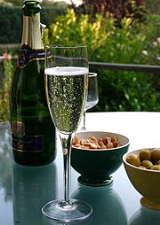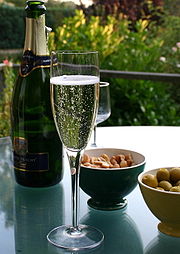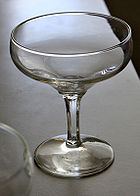
Champagne stemware
Encyclopedia

Stemware
Stemware is drinkware that stands on stems above a base. It is usually made from glass, but may be made from ceramics or metals.Stemware includes:* Wine glasses* Champagne flutes* Chalices and goblets...
refers to the flute and coupe glasses used in the enjoyment of champagne, other sparkling wine
Sparkling wine
Sparkling wine is a wine with significant levels of carbon dioxide in it making it fizzy. The carbon dioxide may result from natural fermentation, either in a bottle, as with the méthode champenoise, in a large tank designed to withstand the pressures involved , or as a result of carbon dioxide...
s, and certain beer
Beer
Beer is the world's most widely consumed andprobably oldest alcoholic beverage; it is the third most popular drink overall, after water and tea. It is produced by the brewing and fermentation of sugars, mainly derived from malted cereal grains, most commonly malted barley and malted wheat...
s.
Champagne flute
The champagne flûte (fr. Flûte à Champagne) is a stem glass with a tall, narrow bowl. The bowl of a flute may resemble a narrow wine glass as seen in the illustration; or a trumpet shape; or be very narrow and straight-sided.As with other stemware, the stem allows the drinker to hold the glass without affecting the temperature of the drink. The bowl is designed to retain champagne's signature carbonation
Carbonation
Carbonation is the process of dissolving carbon dioxide in water. The process usually involves carbon dioxide under high pressure. When the pressure is reduced, the carbon dioxide is released from the solution as small bubbles, which cause the solution to "fizz." This effect is seen in carbonated...
, by reducing the surface area
Surface area
Surface area is the measure of how much exposed area a solid object has, expressed in square units. Mathematical description of the surface area is considerably more involved than the definition of arc length of a curve. For polyhedra the surface area is the sum of the areas of its faces...
at the opening of the bowl. The flute has largely replaced the champagne coupe or saucer, the shape of which allowed carbonation to dissipate even more rapidly than from a standard wine glass
Wine glass
A wine glass is a type of glass stemware that is used to drink and taste wine. It is generally composed of three parts: the bowl, stem, and foot...
. Its smaller diameter also allows more flutes to be carried on a tray.
Nucleation
Nucleation
Nucleation is the extremely localized budding of a distinct thermodynamic phase. Some examples of phases that may form by way of nucleation in liquids are gaseous bubbles, crystals or glassy regions. Creation of liquid droplets in saturated vapor is also characterized by nucleation...
in a champagne glass helps form the bubbles seen in champagne. Too much nucleation will cause the carbonation to fizzle out quickly. A smoother surface area will produce fewer bubbles in the glass, and more bubble texture in the taster's mouth.
While most commonly used for sparkling wines, flutes are also used for certain beers, especially Belgian lambic
Lambic
Lambic is a very distinctive type of beer brewed only in the Pajottenland region of Belgium and in Brussels itself at the Cantillon Brewery and museum...
and gueuze
Gueuze
Gueuze is a type of lambic, a Belgian beer. It is made by blending young and old lambics into a new beer, which is then bottled for a second fermentation. Because the young lambic is not fully fermented, it contains fermentable sugars, which allow the second fermentation to occur...
, which are brewed with wild yeast and often fruited. The tart flavor of these beers, coupled with their carbonation, makes them similar to sparkling white wines, and the champagne flute an ideal choice of glassware.
Champagne coupe

Marie Antoinette
Marie Antoinette ; 2 November 1755 – 16 October 1793) was an Archduchess of Austria and the Queen of France and of Navarre. She was the fifteenth and penultimate child of Holy Roman Empress Maria Theresa and Holy Roman Emperor Francis I....
, Joséphine de Beauharnais
Joséphine de Beauharnais
Joséphine de Beauharnais was the first wife of Napoléon Bonaparte, and thus the first Empress of the French. Her first husband Alexandre de Beauharnais had been guillotined during the Reign of Terror, and she had been imprisoned in the Carmes prison until her release five days after Alexandre's...
, Madame de Pompadour
Madame de Pompadour
Jeanne Antoinette Poisson, Marquise de Pompadour, also known as Madame de Pompadour was a member of the French court, and was the official chief mistress of Louis XV from 1745 to her death.-Biography:...
, or one of several other French aristocrats, although this is almost certainly false. The glass was designed especially for champagne in England in 1663, preceding those aristocrats by almost a century.
The coupe came into fashion in the 1930s. It was popularized in post-prohibition
Prohibition in the United States
Prohibition in the United States was a national ban on the sale, manufacture, and transportation of alcohol, in place from 1920 to 1933. The ban was mandated by the Eighteenth Amendment to the Constitution, and the Volstead Act set down the rules for enforcing the ban, as well as defining which...
America at the Stork Club
Stork Club
The Stork Club was a nightclub in New York City from 1929 to 1965. From 1934 onwards, it was located at 3 East 53rd Street, just east of Fifth Avenue...
, where champagne flowed freely and celebrities had bottles of champagne sent to their tables, compliments of the house. The coupe was the champagne glass of choice through the 1960s
1960s
The 1960s was the decade that started on January 1, 1960, and ended on December 31, 1969. It was the seventh decade of the 20th century.The 1960s term also refers to an era more often called The Sixties, denoting the complex of inter-related cultural and political trends across the globe...
.
The broad surface area allows champagne to lose its carbonation more quickly, making it less suitable for the current style of very dry champagnes, compared to the sweeter champagnes that were popular in the 1930s, and therefore fell out of fashion except for traditional occasions such as weddings. The coupe is now more commonly used for certain cocktail
Cocktail
A cocktail is an alcoholic mixed drink that contains two or more ingredients—at least one of the ingredients must be a spirit.Cocktails were originally a mixture of spirits, sugar, water, and bitters. The word has come to mean almost any mixed drink that contains alcohol...
s such as daiquiri
Daiquiri
Daiquiri is a family of cocktails whose main ingredients are rum, lime juice, and sugar or other sweetener. There are several versions, but those that gained international fame are the ones made in the El Floridita bar in Havana, Cuba....
s.
White wine tulip glass
Champagne is a white wine, and can be served in white wine glasses. Some oenophiles prefer this, particularly in a "tulip" or "belly" shape in which the rim of the glass is narrower than the midpoint, as it permits the drinker to get more of the aroma than a traditional flute, while still not having enough surface area to cause the champagne to quickly lose carbonation.Innovations and novelties
In the 1990s, double-wall stemware came into vogue for champagnes as well as other beverages. The inside and outside of the glass are separated by a small air gap to retard the transfer of heat from the drinker's hand to the drink. An additional novelty designed by Alissia Melka Teichroew and sold by the Museum of Modern ArtMuseum of Modern Art
The Museum of Modern Art is an art museum in Midtown Manhattan in New York City, on 53rd Street, between Fifth and Sixth Avenues. It has been important in developing and collecting modernist art, and is often identified as the most influential museum of modern art in the world...
came on the market in 2004, the "inside-out" double-wall glass in which the inner wall is molded in the traditional shape, but the outer wall is simply cylindrical. When filled, the color of the contents reveals the traditional shape.MoMa Inside Out Champagne Glass
Another stem variation is the "stemless" champagne flute.
External links
- Flute, Tulip, or Coupe?, Oenophile Blog.
- How to Serve Champagne, IntoWine.Com

